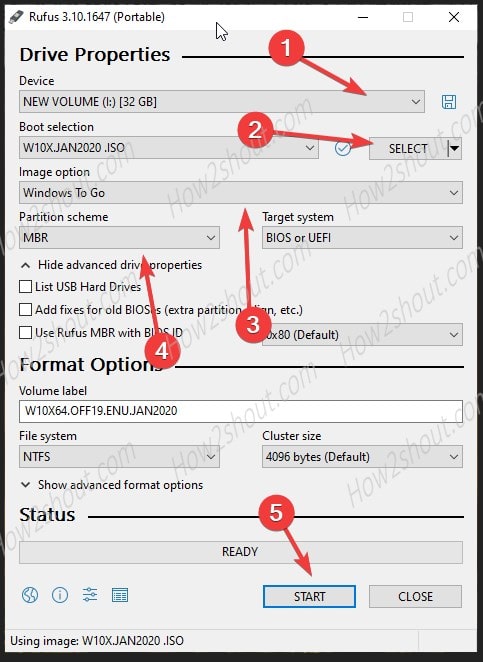

- #HOW TO USE RUFUS HOW TO#
- #HOW TO USE RUFUS INSTALL#
- #HOW TO USE RUFUS UPDATE#
- #HOW TO USE RUFUS PORTABLE#
#HOW TO USE RUFUS UPDATE#
The main highlight of the update is the ability to make a Windows 11 installation media without Microsofts security requirements. Vtsi files (Ventoy Sparse Image, courtesy of Add workaround for openSUSE Live ISOs Rufus, a neat third-party utility to create bootable USB drives in Windows, received an update to version 3.16 Beta 2. you need to flash a BIOS or other firmware from DOS.you need to work on a system that doesn't have an OS installed.you need to create USB installation media from bootable ISOs (Windows, Linux, UEFI, etc.).It can be especially useful for cases where: A non-exhaustive list of Rufus supported ISOs is available here. It is also marginally faster on the creation of Linux bootable USBs from ISOs. For instance it's about twice as fast as UNetbootin, Universal USB Installer or Windows 7 USB download tool, on the creation of a Windows 7 USB installation drive from an ISO (with honorable mention to WiNToBootic for managing to keep up). Despite its small size, Rufus provides everything you need! Oh, and Rufus is fast. In addition to the regular installer, a portable version of Rufus is also available for. Step 2: Download and run Rufus 3.5 or later version. Step 1: Connect an 8GB+ USB drive which you would like to make a bootable USB.
#HOW TO USE RUFUS HOW TO#
Therefore we would highly recommend to give a shot to Rufus.Rufus is a small utility that helps format and create bootable USB flash drives, such as USB keys/pendrives, memory sticks, etc. Here is how to use Rufus 3.5 to download Windows 10 and then prepare a bootable USB. Since it is a portable one it will not reserve any space in the device.

In that case, you can always give this application a try.
#HOW TO USE RUFUS INSTALL#
Thus the conclusion is that this is not that difficult to Use Rufus to Install Windows 10. Here, you may like to learn How to Boot Windows 10 From USB Flash Drive. In the end, you receive a bootable USB flawlessly with Windows 10 which will ultimately be used to install the OS. Now, give an attempt to boot the device with the bootable media that you have generated using Rufus. Lastly, click the OK button to continue with the task.

Step 7 – The software will now prompt a warning box. Step 6 – Finally, click the Start button and let the tool begin the creation. Then press the CD/DVD icon and reach out to Windows 10 ISO image file. Step 5 – Then move ahead to the New Volume label option and put in the value. It is important to mention here that in case you are completely assured that the device works with BIOS then put in NTFS as it has a faster installation. Put in FAT32 (default) there because it is the safest way for the reason as it works for both BIOS and UEFI. Step 4 – Now, click the File system section to fill up that blank. Step 3 – Here, in the Device segment, select the just inserted USB, also choose the MBR break-up type of BIOS or UEFI computers as per the device. Click the Yes button in the UAC prompt to launch the tool. Step 2 – Click on the Rufus utility to proceed with the creation of bootable. Kindly ensure to backup the data of the USB. Step 1 – At the first place plug in any 4GB+ USB drive into the computer. Note – Rufus is a portable one that does not need any sort of installation.

Step 1 – Reach out to this page to grab this software, Rufus. How to Use Rufus to Install Windows 10 Download Rufus


 0 kommentar(er)
0 kommentar(er)
